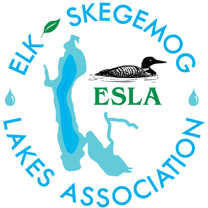Description:
Skegemog Lake is situated between Torch Lake and Elk Lake. It was formerly known as Round Lake. It is connected to Elk Lake via a 1/4 mile-wide, seven-foot deep narrows (called the Skegemog Narrows). Elk and Skegemog Lakes are at the same elevation.
The majority of the shoreline of Skegemog Lake is undeveloped. Public access sites include two MDNR boat launches, several road endings, Grand Traverse Regional Land Conservancy preserves, and the parcels that comprise the Skegemog Natural Area.
The wetland on the lake’s eastern end and around the mouth of the Torch River (known as the Skegemog Swamp) is one of the largest in the region.
The nearshore bottom sediments of Skegemog Lake are primarily sand (70%) followed by a mixture of rocks, gravel and sand (29%), with the rest (mostly in the eastern end) being soft muck or marl. The eastern end of the lake is shallow, and submerged logs and stumps are present quite a way offshore in places. The logs and stumps are from trees that once grew in a lakeside conifer swamp which were inundated by impoundment from the Elk Rapids dam.
About half of the nearshore shallows are vegetated with muskgrass (or Chara), sago pondweed, and other species, with the remainder being mostly unvegetated. Because of Skegemog Lake’s fairly clear waters and shallow depth, aquatic plants grow throughout much of the lake. The only named tributaries are the Torch River, Desmond Creek, and Barker Creek.
Fish species identified during various DNR surveys include walleye, bullhead, rock bass, large- and smallmouth bass, white sucker, yellow perch, bluegill, brown and rainbow trout, bullhead, channel catfish, northern pike, longnose gar, muskellunge, cisco, pumpkinseed, and rosyface and golden shiners.
Monitoring and Research:
Black Lake is monitored through the Watershed Council’s Comprehensive Water Quality Monitoring (CWQM) Program and Volunteer Lake Monitoring (VLM) Program.
The Elk River Chain of Lakes Watershed Plan Implementation Team meets regularly and is working to protect the lakes in the Chain.
Additional Resources:
See additional resources on our Aquavist page.
A wide variety of maps for this area are available online at the Michigan Natural Features Inventory (MNFI) Data Resources page.
| Title | Link |
|---|---|
| Comprehensive Water Quality Monitoring (CWQM) | |
| 2022 Elk River Chain of Lakes Watershed Management Plan | |
| 2017 Skegemog Lake Shoreline Survey | |
| 2014-2015 Elk River Invasive Species Monitoring Project Report | |
| 2011 Elk-Skegemog Lakes Profile CWQM | |
| 2010 Elk River Chain of Lakes Profile CWQM |
The mission of the Elk Skegemog Lakes Association (ESLA) is to do all things and take such actions as may be necessary or desirable to protect and preserve the environment of the area of the Elk-Skegemog watershed, including connecting lakes, streams and wetlands.


